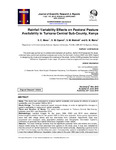Rainfall Variability Effects on Pastoral Pasture Availability in Turkana Central Sub-County, Kenya

View/
Date
2016Author
Moso, D. C
Ogendi, G. M
Makindi, Stanley Maingi
Maina, G. M.
Metadata
Show full item recordAbstract
This study was conducted to analyse rainfall variability and assess its effects on pasture
availability, over the period 1983 to 2014.
Study Design: The study employed causal research design, in order to highlight the changes in
pasture availability in response to rainfall variability.
Place and Duration of Study: The study was conducted in Turkana Central Sub-County,
between June 2014 and December 2014.
Methodology: Landsat images for the years 1984, 2002 and 2014 were obtained.
Meteorological rainfall data for the period 1983 to 2014 was acquired. Focus group discussions
were held with village elders and key informants from Livestock Department. Data was
processed and analysed using descriptive statistics and Geographic Information Systems
softwares, to generate Normalized Difference Vegetation Index values.
Results: The study findings revealed that the significant pastures were tree leaves and shrubs,
Acacia tortilis being the most abundant tree species in the study area. It was also established
that the amount of rainfall received in Turkana Central varied annually, displaying a general trend
of 160.7 mm increase over the thirty-two years. Consequently, pasture availability increased; the
mean Normalized Difference Vegetation Index value in the year 1984 was 0.262, whereas it was 0.377 in the year 2014. However, with the reduction of the drought cycle from 10 to 2 years,
pasture scarcity had become more severe in the recent past.
Conclusion: Increasing amount and variability in rainfall led to increase in pastures. However,
unlike in the past, severe pasture scarcity is experienced during droughts, which are becoming
more recurrent, intense and prolonged.
